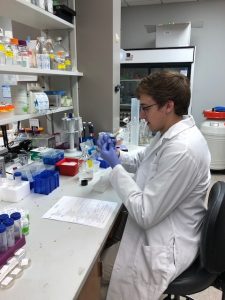
By Adam Pecoraro, Summer Intern in Dr. Seth Kullman’s lab
Flame retardants (FRs) are unique chemical compounds that are added to many products including piping infrastructure, electrical circuit boards, clothing, and furniture in order to decrease the likelihood of fire. FRs use has increased worldwide in recent years, along with human exposure. Research has shown widespread FR exposure in adults and children and various health risks.1
Two common categories of FRs used in the U.S. are organophosphorus flame retardants (OPFRs) and brominated flame retardants (BFRs). Research has shown that both OPFRs and BFRs have the potential to bioaccumulate and cause toxicity in humans and laboratory animals.2 This raises questions about the potential health complications if people are exposed to OPFRs and BFRs for extended periods of time.
The chemical structure of certain FRs allow them to bind to and activate specific hormone receptors in the human body, which can negatively impact metabolism and other functions. To better understand those effects, the focus of Project 2 at the Duke Superfund Research Center is to understand how FRs such as halogenated phenolic compounds (HPCs) and aryl organophosphorus ethers (AOPEs) can affect the pathways that determine the development of either adipocytes (fat cells) or osteocytes (bone cells). Through the work of Drs. Seth Kullman, Heather Stapelton, and Lee Ferguson, we were able to explore which flame retardants were associated with which effects and at what quantities they’re present in the environment. 
After working in Dr. Kullman’s lab as an Undergraduate Research Assistant during the spring semester of 2018, I was able to hit the ground running with my internship project. Specifically, I investigated how exposure to different dosages of the flame retardants triphenyl phosphate (TPP) and tetrabromobisphenol A (TBBPA) can affect skeletal and cartilage development and morphology in zebrafish. I investigated this using two methods: (1) in-vivo exposure experiments with a specialized staining and imaging protocol; and (2) analysis of gene markers related to skeletal integrity and density using quantitative reverse transcription polymerase chain reaction (rt-qPCR).

Zebrafish are excellent laboratory organisms to use when modeling environmental exposures and their impact on human health because the fish are both genetically malleable and similar to humans in terms of functional features. Our chosen methods also allowed us to better characterize the impact of specific flame retardants. Our use of visual and molecular analysis methods allowed us to evaluate zebrafish morphology after exposure and create an overall profile for each FR. This approach helped us to identify which FRs and which specific doses are associated with developmental abnormalities.
My time at the Duke Superfund Research Center was nothing short of incredible. By working under the direction of Dr. Kullman and collaborating with graduate students, I learned something new every day and advanced my understanding of how early life exposures to common environmental chemicals such as FRs can affect development and lead to later life consequences. Connecting with my fellow interns at our weekly meetings made this experience all the more fun, and I enjoyed seeing everyone and hearing about how their respective projects were progressing. The opportunity that Duke gave to conduct and manage my own project this summer was invaluable, and I look forward to future research that works to helps protect the environment and human health.
Sources:
- Hammel, SC, Hoffman, K, Lorenzo, AM, Chen, A, Phillips, AL, Butt, CM, Sosa, JA, Webster, TF, and Stapleton, HM. “Associations between flame retardant applications in furniture foam, house dust levels, and residents’ serum levels.” Environment international 107 (October 2017): 181-189.
- Thomas, MB, Stapleton, HM, Dills, RL, Violette, HD, Christakis, DA, and Sathyanarayana, S. “Demographic and dietary risk factors in relation to urinary metabolites of organophosphate flame retardants in toddlers.” Chemosphere 185 (October 2017): 918-925





